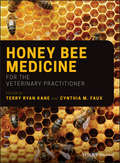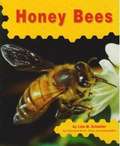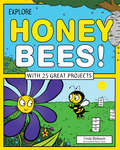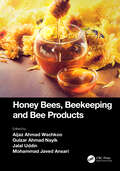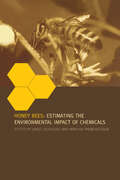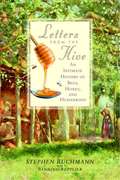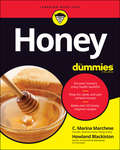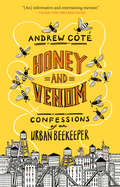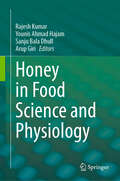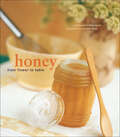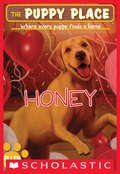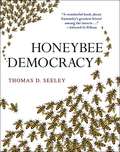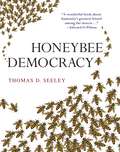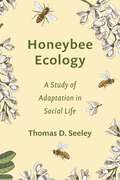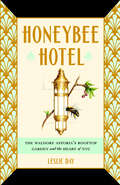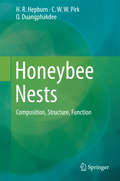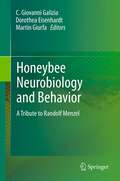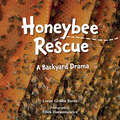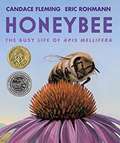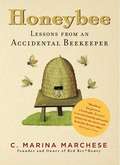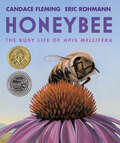- Table View
- List View
Honey Bee Medicine for the Veterinary Practitioner
by Terry Ryan Kane Cynthia M. FauxAn essential guide to the health care of honey bees Honey Bee Medicine for the Veterinary Practitioner offers an authoritative guide to honey bee health and hive management. Designed for veterinarians and other professionals, the book presents information useful for answering commonly asked questions and for facilitating hive examinations. The book covers a wide range of topics including basic husbandry, equipment and safety, anatomy, genetics, the diagnosis and management of disease. It also includes up to date information on Varroa and other bee pests, introduces honey bee pharmacology and toxicology, and addresses native bee ecology. This new resource: Offers a guide to veterinary care of honey bees Provides information on basic husbandry, examination techniques, nutrition, and more Discusses how to successfully handle questions and ‘hive calls’ Includes helpful photographs, line drawings, tables, and graphs Written for veterinary practitioners, veterinary students, veterinary technicians, scientists, and apiarists, Honey Bee Medicine for the Veterinary Practitioner is a comprehensive and practical book on honey bee health.
Honey Bees
by Jane LechtHoneybees work very hard every day. Find out what they do, and why they do it. Find out how they live and how hard they work.
Honey Bees (Honey Bees Series)
by Gail Saunders-Smith Lola SchaeferSimple text and photographs introduce the body parts of honeybees.
Honey Bees!
by Cindy BlobaumWhat did you have for breakfast this morning? Toast, cereal, juice, and fruit? Thank the honey bees! About one out of every three mouthfuls we eat is affected by honey bee pollination. In Explore Honey Bees! With 25 Great Projects, young readers learn about honey bee colonies, why honey bees live in hives, how honey bees communicate with each other, and why they are so important to human lives. Colony collapse disorder first appeared in 2006 and since then beekeepers have seen disappearances of 30 to 90 percent of their bee colonies each year. Readers learn about possible reasons behind and solutions to this growing global problem. Explore Honey Bees! offers a glimpse into a miniature world familiar to children. Activities include designing a hive and making a model of a flower’s reproductive system, reinforcing the math and science skills readers gain from the text. Fun facts and colorful illustrations make learning fun and exciting. Links to online primary sources integrate a digital learning experience and offer opportunities to delve deeper into the world of honey bees. This title meets Common Core State Standards in language arts, science and technology; Guided Reading Levels and Lexile measurements indicate grade level and text complexity.
Honey Bees, Beekeeping and Bee Products
by Aijaz Ahmad Wachkoo, Gulzar Ahmad Nayik, Jalal Uddin and Mohammad Javed AnsariHoney bees are social insects; they live together in large, well-organized family groups comprising three castes: queen (fertile female), workers (sterile females) and drones (males). During honey flow season, there is a considerable increase in the foraging activity of the workers and in the rate of egg laying by the queen. Sex determination in honey bees involves a multi-allelic locus, such that homozygotes develop as males and heterozygotes as females, whereas diet quality influences the caste determination in honey bees. Like all living organisms, honey bees can be infested with diseases and pests. Some of these are more deleterious to bee colonies than others, but it is important for the beekeeper to be able to recognize conditions that might be disease or pest-related and respond accordingly so as to improve the quality of honey and honey bee by-products.The best-known primary products of beekeeping are honey and wax, but pollen, propolis, royal jelly, venom, queens, bees and their larvae are also marketable primary bee products. The purpose of this book is to make available information on bee biology and beekeeping as well as to provide comprehensive information on manufacturing, processing and marketing of value-added bee products.This book has been designed as a useful tool for the many diverse professionals who characterize and market honey bee products, including beekeepers, non-beekeepers, small entrepreneurs, extension officers and those involved in small business development. This edited book will be the first of its kind to contain comprehensive information on both bees and bee products.Key Features: Contains comprehensive information on beekeeping. Discusses the recent advances in beekeeping. Sheds light on bee colony integration and organization. Contains brief information on honey bee products.
Honey Bees: Estimating the Environmental Impact of Chemicals
by James Devillers Minh-Hà Pham-DelègueHoney Bees: Estimating the Environmental Impact of Chemicals is an updated account of the different strategies for assessing the ecotoxicity of xenobiotics against these social insects, which play a key role in both ecology and agriculture. In addition to the classical acute laboratory test, semi-field cage tests and full field funnel tests, new te
Honey Bees: Letters from the Hive
by Stephen Buchmann Banning RepplierIn Honey Bees: Letters From the Hive, bee expert Stephen Buchmann takes readers on an incredible tour. Enter a beehive--one part nursery, one part honey factory, one part queen bee sanctum--then fly through backyard gardens, open fields, and deserts where wildflowers bloom. It's fascinating--and delicious! Hailed for their hard work and harmonious society, bees make possible life on earth as we know it. This fundamental link between bees and humans reaches beyond biology to our environment and our culture: bees have long played important roles in art, religion, literature, and medicine--and, of course, in the kitchen. For honey fanatics and all who have a sweet tooth, this book not only entertains and enlightens but also reminds us of the fragility of humanity's relationship with nature.
Honey Bunch and Norman Visit Beaver Lodge (Honey Bunch #34)
by Helen Louise ThorndykeHoney Bunch Morton--whose real name is Gertrude Marion Morton, although nobody ever calls her that--is a six-year-old girl off on another adventure with her six-year-old neighbor playmate, Norman Clark.<P>Norman sees a big swimming cat down at Barham Pond and Honey Bunch wants to see it for herself, knowing cats don't like water. Henry, the "Park Custodian" tells the children that the "cat" is actually "Mr. Slapper", a beaver caught by a trapper friend of Henry's. But the friend was moving and couldn't keep the beaver as a pet any more. So the friend gave the beaver to Barham Park. Then Henry tells the children "Beavers like company. We should really have another beaver so that Mr. Slapper would have a playmate."<P>Honey Bunch gets an idea that she and Daddy and Mother and Norman could go on a vacation to a place where there were beavers. Then she might find a playmate to bring back for Mr. Slapper... <P>"Honey Bunch #34", aka "Honey Bunch and Norman #6".<P>"Helen Louise Thorndyke" is a pseudonym of "Harriet S. Adams".
Honey For Baby Bear (Rigby PM Platinum #Blue (Level 9-11))
by Beverley Randell Isabel LoweBaby Bear goes into the forest to look for honey, and can't find his way home.
Honey For Dummies
by Howland Blackiston C. Marina MarcheseGet in on the ground level of the next artisan food obsession—honey! Just like wine, cheese, beer or coffee, honey is an artisan food with much to be discovered. Whether you're interested in tasting the various varietals, using it as a cure, or harvesting your own, Honey For Dummies is the guide for you. This book reveals the deep and complex world of honey, its diverse floral sources, and its surprising range of colors, smells, and flavors. You will learn about over 50 single-origin honeys, their sensory profiles, where they are produced and where to buy them. Discover how to taste and evaluate honey using the same methods as professional honey sensory expert. Understand how honey is produced by honeybees, and how beekeepers harvest, and bottle this liquid gold. You'll also discover the historical role honey has played around the world in folklore, religions, and economies. From its health benefits, to recipes, to food pairings, this complete guide covers all things honey! Honey is the latest food trend that can be found at farmers' markets, specialty food shops and on the menu of restaurants. It is produced from bees in every state and just about every country on the planet. Let Honey For Dummies accompany you on your sweet adventure! Discover the rich and complex world of single-origin honey Learn about honey's composition and its myriad health benefits Acquire the skills to taste honey like a pro then how to perfectly pair honeys with all foods Try the book's many wonderful recipes that incorporate honey Honey For Dummies is the perfect companion for every chef, brewer, homesteader, beekeeper or honey lover.
Honey and Venom: Confessions of an Urban Beekeeper
by Andrew CotéA year in the life of New York City&’s premier beekeeper, who chronicles his adventures and the quirky personalities he encounters while spreading his infinite knowledge of and passion for the remarkable honey bee. &“Coté&’s charming and poignant essay collection delivers the entertainment and smarts required to make real change in how we look at our planet—and ourselves.&”—Andrew ZimmernConsidered an &“industry legend&” by The New York Times, Andrew Coté has one of the most intriguing, challenging, and unique jobs in New York City—maintaining millions of honey bees atop some of the city&’s most iconic buildings. His apiaries have crowned the Waldorf Astoria and the Museum of Modern Art; reside on the North Lawn of the United Nations; reign above stores, hotels, restaurants, schools, churches, and synagogues; and are situated in community gardens, and even cemeteries, throughout the five boroughs. In this debut collection, Coté takes readers with him on his daily apiary adventures over the course of a year, in the city and across the globe. Here, among his many duties, he is called to capture swarms that have clustered on fire hydrants, air-conditioning units, or street-vendor umbrellas. Annually, he travels with his father to regions like remote Fijian islands, rural Uganda, Haiti, Ecuador, or Iraq with his organization, Bees Without Borders, where he teaches beekeepers how to increase their honey yield and income via beekeeping endeavors. Written with Coté&’s trademark humor, acumen, and a healthy dose of charm, Honey and Venom illuminates the obscure culture of New York City &“beeks&” and the biology of the bees themselves, from the humble drone to the fittingly named worker to the queen herself—who is more a slave than a monarch. The hive world, Coté reveals, is full of strivers and slackers, givers and takers, and even some insect promiscuity—startlingly similar to the prickly human variety. For Coté, a fourth-generation beekeeper, this is a family tradition, and this personal significance pervades his celebration of the romance and mystery of bees, their honey, and the beekeepers whose lives revolve around these most magical creatures.
Honey in Food Science and Physiology
by Rajesh Kumar Sanju Bala Dhull Younis Ahmad Hajam Arup GiriThis book highlights the science underlying honey, which is central to an understanding of conventional medicine or ingredients of food used mostly in all societies and it is attracting increasing interest among food scientists and professionals worldwide. Honey, wax, propolis and royal jelly also have significant roles in various nutraceutical and pharmaceutical products and this book provides collective information and practical approaches regarding all characteristic features of honey and its applications as functional food and medicines. Not only does this book explain the comprehensive knowledge of honey and its medicinal properties based on current researched evidence, it also explores the contribution of honey in the food science and medicine industry as a significant part of nutraceuticals and functional food research. Written by leading scientists in the field, the book will be a valuable resource for students and researchers in the fields of food chemistry, nutritional science, taste physiology, and neuroscience, as well as for professionals in the food industry.
Honey... Honey... Lion!
by Jan BrettThe African plains provide a stunning environment for Jan Brett's latest animal adventure. For as long as anyone can remember, the honeyguide bird and the African honey badger have been partners when it comes to honey:Honeyguide finds the honeycomb, Badger breaks it open, and they share the sweetness inside.But this day, Badger keeps all the honey for himself. Foolish Badger!In no time, Honeyguide leads Badger on a fast chase. Badger thinks it's for honey; but Honeyguide has a surprise waiting for her greedy friend.As they swim across a pond, push through a thicket of reeds, leap over a huge anthill, a menagerie of exotic animals passes the news along in a kind of animal Bush Telegraph. Finally Badger faces a lift-the-flap page, revealing the twist that teaches Badger a lesson. Can you guess who's under that flap?Honey . . . Honey . . . Lion! will surely become a family favorite for readers of all ages.
Honey: From Flower to Table
by Stephanie Rosenbaum“Stephanie Rosenbaum gives all the buzz about honey, including chapters on history, cooking and crafting.” —Publishers WeeklyIn the winning format of the highly successful The Lavender Garden, Honey: From Flower to Table dips into the myth, magic, science, and literature behind this sacred and sensuous food. Author Stephanie Rosenbaum traces the amazing process that turns flower nectar into honey, and takes the reader on a fascinating tour of the history and symbolism of honey. Cooking and crafting chapters include recipes for mouthwatering honey delicacies and step-by-step instructions for simple crafts like honeycomb candles and lip balms. A sumptuous feast for the senses, Honey makes a perfect gift for Mother’s Day, honey lovers, or anyone who fills life with sweet inspiration.
Honey: Honey (The Puppy Place #16)
by Ellen MilesWelcome to the Puppy Place--where every puppy finds a home!In this special Valentine's Day story, Charles and his best friend Sammy meet Honey, a sweet, intelligent yellow Lab who's family is moving away--without Honey! When Charles brings this puppy home, guess who falls in love? Charles's mom--the cat lover of the family! Will the Petersons end up keeping Honey? Or will Honey become a service dog and best pal for Noah, a talented artist who uses a wheelchair? One thing is for certain: puppy love is in the air!
Honeybee Democracy
by Thomas D. SeeleyHoneybees make decisions collectively--and democratically. Every year, faced with the life-or-death problem of choosing and traveling to a new home, honeybees stake everything on a process that includes collective fact-finding, vigorous debate, and consensus building. In fact, as world-renowned animal behaviorist Thomas Seeley reveals, these incredible insects have much to teach us when it comes to collective wisdom and effective decision making. A remarkable and richly illustrated account of scientific discovery, Honeybee Democracy brings together, for the first time, decades of Seeley's pioneering research to tell the amazing story of house hunting and democratic debate among the honeybees. In the late spring and early summer, as a bee colony becomes overcrowded, a third of the hive stays behind and rears a new queen, while a swarm of thousands departs with the old queen to produce a daughter colony. Seeley describes how these bees evaluate potential nest sites, advertise their discoveries to one another, engage in open deliberation, choose a final site, and navigate together--as a swirling cloud of bees--to their new home. Seeley investigates how evolution has honed the decision-making methods of honeybees over millions of years, and he considers similarities between the ways that bee swarms and primate brains process information. He concludes that what works well for bees can also work well for people: any decision-making group should consist of individuals with shared interests and mutual respect, a leader's influence should be minimized, debate should be relied upon, diverse solutions should be sought, and the majority should be counted on for a dependable resolution. An impressive exploration of animal behavior, Honeybee Democracy shows that decision-making groups, whether honeybee or human, can be smarter than even the smartest individuals in them.
Honeybee Democracy
by Thomas D. SeeleyHow honeybees make collective decisions—and what we can learn from this amazing democratic processHoneybees make decisions collectively—and democratically. Every year, faced with the life-or-death problem of choosing and traveling to a new home, honeybees stake everything on a process that includes collective fact-finding, vigorous debate, and consensus building. In fact, as world-renowned animal behaviorist Thomas Seeley reveals, these incredible insects have much to teach us when it comes to collective wisdom and effective decision making. A remarkable and richly illustrated account of scientific discovery, Honeybee Democracy brings together, for the first time, decades of Seeley's pioneering research to tell the amazing story of house hunting and democratic debate among the honeybees.In the late spring and early summer, as a bee colony becomes overcrowded, a third of the hive stays behind and rears a new queen, while a swarm of thousands departs with the old queen to produce a daughter colony. Seeley describes how these bees evaluate potential nest sites, advertise their discoveries to one another, engage in open deliberation, choose a final site, and navigate together—as a swirling cloud of bees—to their new home. Seeley investigates how evolution has honed the decision-making methods of honeybees over millions of years, and he considers similarities between the ways that bee swarms and primate brains process information. He concludes that what works well for bees can also work well for people: any decision-making group should consist of individuals with shared interests and mutual respect, a leader's influence should be minimized, debate should be relied upon, diverse solutions should be sought, and the majority should be counted on for a dependable resolution.An impressive exploration of animal behavior, Honeybee Democracy shows that decision-making groups, whether honeybee or human, can be smarter than even the smartest individuals in them.
Honeybee Ecology: A Study of Adaptation in Social Life (Monographs in Behavior and Ecology)
by Thomas D. SeeleyFrom the acclaimed author of Honeybee Democracy, a classic account of the ecological factors that shape the social lives of honeybeesFor many years, research on honeybee social life dealt primarily with the physiological processes underlying the social system of the bee rather than the ecological factors that have shaped its societies. Thomas Seeley&’s landmark book unites the two approaches, emphasizing ecological studies of honeybee social behavior while also offering fresh perspectives on honeybee behavior and communication. It covers a broad range of topics, from adaptiveness of worker sterility and the economics of nest construction to information-center foraging, individual versus colony level selection, sex ratio evolution, colonial thermoregulation, evolution of colony defense, and adaptive radiation in colony design. Honeybee Ecology presents honeybees as a model system for investigating advanced social life among insects from an evolutionary perspective.
Honeybee Hotel: The Waldorf Astoria's Rooftop Garden and the Heart of NYC
by Leslie DayThe fascinating story of the urban honeybee garden on the roof of the legendary Waldorf Astoria hotel.The tale of Honeybee Hotel begins over one hundred years ago, with the Astor family and the birth of the iconic Manhattan landmark, the magnificent Waldorf Astoria. In those early days the posh art deco masterpiece had its own rooftop garden for guests to enjoy. Fast-forward to the turn of the twenty-first century, and we meet executive chef David Garcelon, the creative genius behind the idea of restoring the celebrated rooftop garden. His vision included six hives containing some 300,000 honeybees, which would provide a unique flavor for his restaurant’s culinary masterpieces. Yet Garcelon’s dream was much grander than simply creating a private chefs’ garden: he wanted the honeybee garden to serve as a bond among people. Soon the staff of the hotel, the guests, local horticulturists, and beekeeping experts formed a community around the bees and the garden, which not only raised vegetables, herbs, and honey to be served in the hotel but also provided healthy food to the homeless shelter across the street at St. Bartholomew’s Church. Through her meticulous research and interviews with culinary glitterati, entomologists, horticulturists, and urban beekeepers, Leslie Day leads us on a unique insider’s tour of this little-known aspect of the natural world of New York City. She familiarizes us with the history of the architectural and cultural gem that is the Waldorf and introduces us to the lives of Chef Garcelon and New York City’s master beekeeper, Andrew Coté.Day, an urban naturalist and incurable New Yorker, tells us of the garden’s development, shares delectable honey-based recipes from the hotel’s chefs and mixologist, and relates the fate of the hotel in the wake of the Waldorf’s change of ownership. During our journey, we learn quite a bit about apiaries, as well as insect and flower biology, through the lives of the bees that travel freely around the city in search of nectar, pollen, and resin. This absorbing narrative unwraps the heart within the glamour of one of the world’s most beloved cities, while assuring us that nature can thrive in the ultimate urban environment when its denizens care enough to foster that connection.
Honeybee Nests
by H. R. Hepburn C.W.W. Pirk O. DuangphakdeeThis work, a sequel to Honeybees and Wax published nearly 30 years ago, starts with a brief introduction and discussion of nesting sites, their spaces and densities, self-organization of nest contents, and interspecific utilization of beeswax. The following chapters cover communication by vibrations and scents and wax secretion, and discuss the queen in relation to the combs. Discussions on completed nests include the significance of brood, the roles of pollen and nectar flow, and comb-building, and are followed by a triad of related chapters on the construction of cells and combs and their energetic costs. An in-depth examination of the conversion of wax scales into combs, the material properties of scale and comb waxes, and the wax gland complex are presented. The next chapters are devoted to a comprehensive analysis of the literature on the chemistry and synthesis of beeswax, and, finally, the material properties of honeybee silk are highlighted.
Honeybee Neurobiology and Behavior
by Dorothea Eisenhardt Martin Giurfa C. Giovanni GaliziaThe book is a sequel of a similar book, edited by Randolf Menzel and Alison Mercer, "Neurobiology and Behavior of Honeybees", published in 1987. It is a "Festschrift" for the 70th birthday of Randolf Menzel, who devoted his life to the topic of the book. The book will include an open commentary for each section written by Randolf Menzel, and discussed with the authors. The written contributions take their inspiration from a symposium on the topic, with all the authors, that was held in Berlin in summer 2010
Honeybee Rescue: A Backyard Drama
by Loree BurnsFans of the Scientists in the Field series will love discovering ways to save and protect bees through the eyes of a honeybee rescuer. Follow honeybee rescuer Mr. Nelson as he expertly removes a colony of bees from Mr. Connery's barn (with a vacuum!) and helps it relocate back to a hive. Photographs of Mr.Nelson’s relocation of the colony help bring the honeybee rescue to life. <P><P> Nature lovers and scientists-to-be will be abuzz as they learn all the ways to keep honeybees (and our ecosystem) safe. <P><P><i>Advisory: Bookshare has learned that this book offers only partial accessibility. We have kept it in the collection because it is useful for some of our members. Benetech is actively working on projects to improve accessibility issues such as these.</i>
Honeybee The Busy Life of Apis Mellifera: The Busy Life Of Apis Mellifera
by Candace FlemingThe life cycle of a honeybee is explained in this book.
Honeybee: Lessons from an Accidental Beekeeper
by C. Marina MarcheseNow in paperback, Marina Marchese's inspirational and practical story of learning to raise honeybees and creating a life she loves "[An] engaging, delightfully informative work?" ?Publishers Weekly "Marchese has given us a lovely gift. Honeybee is an entertaining and useful primer for the novice and honeybee devotee alike." ?Washington Times "Surpassing the predictable "how I changed careers" memoir of finding the good life, Marchese's informative guide is packed with facts about everything from pollination to harvesting, life cycles to historical lore, nutritional benefits to gourmet flavor combinations, medical applications to unusual varieties." ?BooklistIn 1999, Marina Marchese fell in love with bees during a tour of a neighbor's honeybee hives. She quit her job, acquired her own bees, built her own hives, harvested honey, earned a certificate in apitherapy, studied wine tasting in order to transfer those skills to honey tasting, and eventually opened her own honey business. Today, Red Bee® Honey sells artisanal honey and honey-related products to shops and restaurants all over the country. More than an inspiring story of one woman's transformative relationship with honeybees (some of nature's most fascinating creatures), Honeybee is also bursting with information about all aspects of bees, beekeeping, and honey?including life inside the hive; the role of the queen, workers, and drones; pollination and its importance to sustaining all life; the culinary pleasures of honey; hiving and keeping honeybees; the ancient practice of apitherapy, or healing with honey, pollen, and bee venom; and much more. Recipes for food and personal care products appear throughout. Also included is an excellent, one-of-a-kind appendix that lists 75 different honey varietals, with information on provenance, tasting notes, and food-and-wine pairings.
Honeybee: The Busy Life of Apis Mellifera
by Candace FlemingRobert F. Sibert Medal Winner Take to the sky with Apis, one honeybee, as she embarks on her journey through life!An Orbis Pictus Honor BookSelected for the Texas Bluebonnnet Master ListFinalist for the AAAS/Subaru SB&F Prize for Excellence in Science Books A tiny honeybee emerges through the wax cap of her cell. Driven to protect and take care of her hive, she cleans the nursery and feeds the larvae and the queen. But is she strong enough to fly? Not yet! Apis builds wax comb to store honey, and transfers pollen from other bees into the storage. She defends the hive from invaders. And finally, she begins her new life as an adventurer. The confining walls of the hive fall away as Apis takes to the air, finally free, in a brilliant double-gatefold illustration where the clear blue sky is full of promise-- and the wings of dozens of honeybees, heading out in search of nectar to bring back to the hive. Eric Rohmann's exquisitely detailed illustrations bring the great outdoors into your hands in this poetically written tribute to the hardworking honeybee. Award-winning author Candace Fleming describes the life cycle of the honeybee in accessible, beautiful language. Similar in form and concept to the Sibert and Orbis Pictus award book Giant Squid, Honeybee also features a stunning gatefold and an essay on the plight of honeybees.Cook Prize Honor BookA Kids' Book Choice Award FinalistAn American Library Association Notable Children&’s BookA New York Public Library Best Book of the YearNamed a Best Book of the Year by Kirkus Reviews, NPR, Shelf Awareness, School Library Journal, Publishers Weekly and more!A Horn Book Fanfare Best Book of the YearA Bank Street Best Children's Book of the Year!A Bulletin of the Center for Children's Books Blue Ribbon BookA Booklist Editor's ChoiceNamed to the Texas Topaz Reading ListA Junior Library Guild Gold Standard Selection
